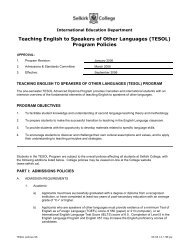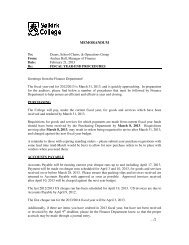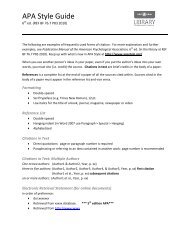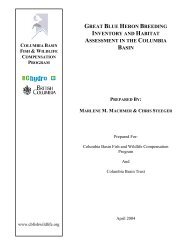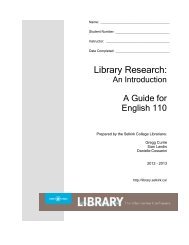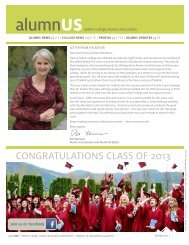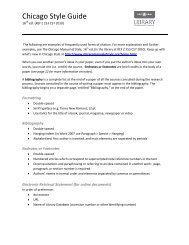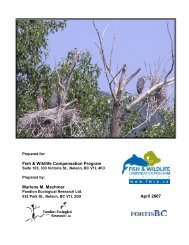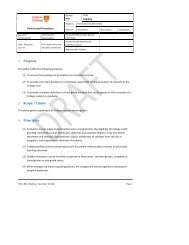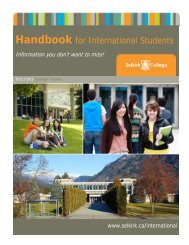selk irk.ca - Selkirk College
selk irk.ca - Selkirk College
selk irk.ca - Selkirk College
You also want an ePaper? Increase the reach of your titles
YUMPU automatically turns print PDFs into web optimized ePapers that Google loves.
Forest Technology<br />
ENVR 162 Applied Botany and<br />
Ecosystem Classifi<strong>ca</strong>tion<br />
This course is an introduction to the basics of<br />
Botany and Ecosystem Classifi<strong>ca</strong>tion. Botany<br />
lectures will focus on plant classifi<strong>ca</strong>tion, botani<strong>ca</strong>l<br />
terms, plant morphology, and plant physiology.<br />
Topics include: plant cells, tissues, and organ<br />
structure and function, photosynthesis and<br />
respiration transpiration and translo<strong>ca</strong>tion.<br />
During botany labs, students will learn to identify<br />
about 100 native plants commonly found in the<br />
West Kootenay Region of BC.<br />
Ecology lectures will focus on ecosystem<br />
classifi<strong>ca</strong>tion using the Biogeoclimatic Ecosystem<br />
Classifi<strong>ca</strong>tion System (BEC) of BC. Other key<br />
topics include the study of climatic factors and<br />
climate change, disturbance and succession, and<br />
lands<strong>ca</strong>pe and stand structure. Ecology labs focus<br />
on classifying ecosystems (including soils, site<br />
and vegetation) to site series using BEC. Labs are<br />
mainly field based.<br />
ENVR 164 Soil and Earth Sciences<br />
This course will cover the identifi<strong>ca</strong>tion of common<br />
rocks and minerals, landforms and soils of British<br />
Columbia. Learners will be introduced to the study<br />
of physi<strong>ca</strong>l geology and geomorphology in relation<br />
to management of the forest environment and<br />
lands<strong>ca</strong>pe. Learners will gain skills and knowledge<br />
in rock and mineral identifi<strong>ca</strong>tion, description of<br />
the physi<strong>ca</strong>l and chemi<strong>ca</strong>l qualities of soils, and<br />
identifi<strong>ca</strong>tion and classifi<strong>ca</strong>tion of landforms and<br />
terrain. Skills will also be developed with respect to<br />
interpretation of geology, landforms and soils for<br />
environmental management.<br />
ENVR 190 Computer Appli<strong>ca</strong>tions I<br />
This course builds on computer skills students<br />
have previously acquired. Applied intermediate to<br />
advanced computer appli<strong>ca</strong>tions specific to <strong>ca</strong>reer<br />
opportunities in the environment and geomatics<br />
sector are covered including file management,<br />
word processing for report writing, spreadsheets<br />
and an introduction to databases.<br />
MATH 160 Techni<strong>ca</strong>l Mathematics<br />
This is an applied math course, focusing on the<br />
techni<strong>ca</strong>l math skills required in Renewable<br />
Resources work. Topics include: computation,<br />
2-D and 3-D trigonometry, conversion factors,<br />
derived and empiri<strong>ca</strong>l formulas, exponentials and<br />
logarithms, and map s<strong>ca</strong>les.<br />
Prerequisites<br />
Principles of Math 11, Principles or Appli<strong>ca</strong>tions<br />
of Math 12, Math 80 or equivalent.<br />
TWC 150 Introduction to<br />
Techni<strong>ca</strong>l Communi<strong>ca</strong>tions I<br />
A review of basic English skills is undertaken in<br />
this course. Also included is an introduction to<br />
general principles in written techni<strong>ca</strong>l communi<strong>ca</strong>tion<br />
and its appli<strong>ca</strong>tion to renewable resource<br />
management. Classroom sessions focus on<br />
developing writing skills, a<strong>ca</strong>demic research and<br />
documentation, the organization and interpretation<br />
of data, oral presentation skills, and job<br />
search techniques.<br />
ENVR 154 Applied Mapping<br />
and Remote Sensing<br />
This course emphasizes the practi<strong>ca</strong>l appli<strong>ca</strong>tion<br />
of maps and air photos in resource management.<br />
Students become familiar with types of maps and<br />
air photos, indexing systems, using maps and air<br />
photos in the field, map reading and measuring<br />
techniques, photo interpretation and measuring<br />
techniques, obtaining data for mapping,<br />
stratifi<strong>ca</strong>tion of air photos, and remote sensing<br />
techniques. This course will also cover web-based<br />
remote sensing technologies and appli<strong>ca</strong>tions in<br />
environmental management.<br />
ENVR 158 Introduction to GIS<br />
This half-semester course is an introduction to<br />
geographic information systems (GIS) theory and<br />
appli<strong>ca</strong>tions. Participants will become familiar the<br />
basic GIS concepts and apply GIS technologies to<br />
environmental, renewable resource management,<br />
and planning fields. Emphasis will be placed on<br />
how geographic data is represented, collected,<br />
managed, analyzed, and displayed using GIS<br />
tools. Hands-on experience will be developed with<br />
the most widely used and comprehensive desktop<br />
GIS software, ESRI’s ArcGIS Desktop.<br />
ENVR 161 Global Positioning<br />
Systems and Navigation<br />
This 1/2 semester course will cover the navigation<br />
skills required in the workforce. The focus is on<br />
hands-on use of navigation tools in field settings<br />
including map, air photo, compass, altimeter, and<br />
Global Positioning Systems (GPS) techniques.<br />
Pre-trip planning in a navigation context will<br />
also be covered including developing access plans<br />
and route plans, and estimating travel times. This<br />
course will build on skills introduced in ENVR<br />
160 Surveying and Field Measurements and ENVR<br />
154 Applied Mapping and Remote Sensing courses.<br />
ENVR 163 Terrestrial<br />
Ecology and Biology<br />
This course builds upon the concepts from ENVR<br />
162 with further studies of lo<strong>ca</strong>l forest ecosystems.<br />
Students will identify key forest structural<br />
components and study the role that disturbance<br />
(such as fire), environmental gradients, and<br />
competition play in defining a species’ niche.<br />
Participants will also examine the role of primary<br />
and secondary growth, nutrient uptake, reproduction,<br />
and survival mechanisms for plants. Winter<br />
plant identifi<strong>ca</strong>tion, ecosystem form and function,<br />
and plant adaptations to timberline will also be<br />
examined. A practi<strong>ca</strong>l field based assignment will<br />
form a major portion of the Semester assessment.<br />
ENVR 170 Fish and Wildlife Ecology<br />
This course will cover identifi<strong>ca</strong>tion and ecology<br />
of vertebrate animals, habitat requirements, and<br />
habitat disturbance impli<strong>ca</strong>tions. Learners will gain<br />
experience in applying guidelines and management<br />
strategies to minimize impact of other resource uses<br />
on fish and wildlife habitat and species.<br />
MATH 190 Resource Statistics I<br />
This course covers standard tests and techniques<br />
of statistics and the appli<strong>ca</strong>tion of these statisti<strong>ca</strong>l<br />
measures in renewable resources management.<br />
Prerequisites<br />
Successful completion of MATH 160.<br />
TWC 151 Introduction to<br />
Techni<strong>ca</strong>l Communi<strong>ca</strong>tions II<br />
An introduction to general principles in written<br />
techni<strong>ca</strong>l communi<strong>ca</strong>tion and oral presentation.<br />
Lectures focus upon business correspondence, the<br />
informal and formal report, techni<strong>ca</strong>l style, and<br />
graphic illustration. Students practice delivery<br />
techniques for oral presentations of techni<strong>ca</strong>l data<br />
in renewable resource management. Collaborative<br />
activities and teamwork skills are practiced and<br />
encouraged.<br />
Prerequisites<br />
TWC 150.<br />
FOR 278 Forestry Field School<br />
This course is made up of ten days of practi<strong>ca</strong>l<br />
field work at the end of the Winter semester.<br />
Major projects are planting, silvicultural measurements,<br />
juvenile spacing, and field mapping and<br />
engineering. This course is scheduled for two<br />
weeks (seventy hours) after final exams in late<br />
April.<br />
Prerequisites<br />
Successful completion of all first year courses.<br />
FOR 250 Silviculture I<br />
This course prepares the students for immediate<br />
employment as a forest technician in British<br />
Columbia through instruction in silvicultural<br />
theory, the appli<strong>ca</strong>tion of silvicultural treatments<br />
and the use of sampling to monitor silviculture<br />
activities. Ecologi<strong>ca</strong>l, operational, economic,<br />
and legislative considerations will be presented.<br />
The emphasis of this course is on the silvics of<br />
southern interior tree species, silviculture surveys,<br />
reforestation (natural and artificial regeneration),<br />
site preparation, field assessments and preparation<br />
of logi<strong>ca</strong>l and feasible reforestation prescriptions.<br />
Field and office <strong>ca</strong>se studies are used throughout.<br />
Prerequisites<br />
All first year courses.<br />
FOR 260 Applied Hydrology<br />
and Engineering<br />
This course covers the planning and establishment<br />
of natural resource road access including total<br />
School of Environment and Geomatics<br />
Selk<strong>irk</strong> <strong>College</strong> 12/13<br />
177




